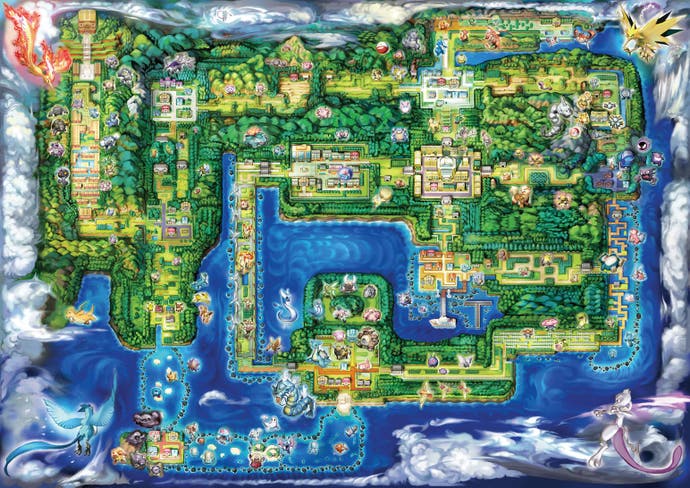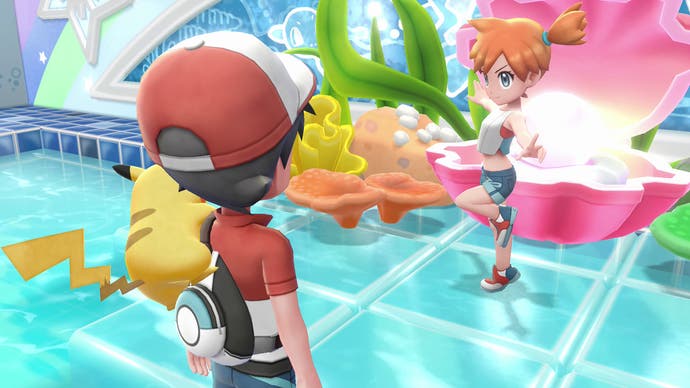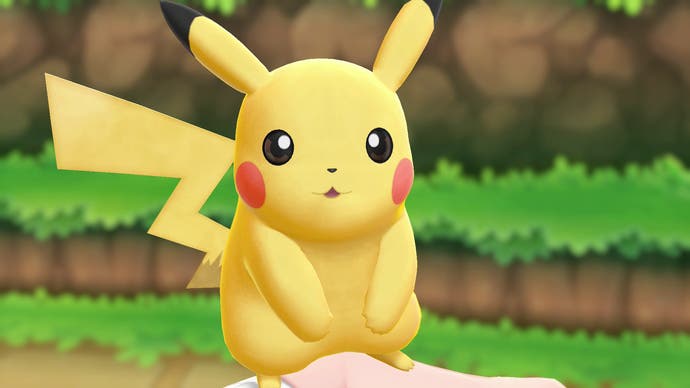Junichi Masuda on Pokémon Let's Go's difficulty, mechanics, and the series' future
"I'd be really sad to think that for fans, Pokémon is just hatching eggs."
Two decades on from Pokémon Red and Blue's arrival here in the west, we're going back to Kanto once again.
Pokémon Let's Go have made big changes - some proving more popular than others in the lead up to its release - but there's still a lingering sense that, with just the first generation of Pokémon available, in the first region, we've seen it all before.
A couple of weeks ago, alongside an extended hands-on preview of Let's Go Pikachu and Eevee, we talked to Junichi Masuda, executive director and head of game development at Pokémon's main studio Game Freak, as well as fellow designer Kensaku Nabana, about some of the nitty gritty details fans are always after, including how that whole Meltan reveal came about, HMs, and those perpetual questions of difficulty, open worlds, and the series' future.

So it's been 20 years since the release of Pokémon Red and Blue in the west - 19 here in Europe - so first of all congratulations. Was that anniversary one of the main reasons you chose to set Let's Go in the Kanto region, as a retelling of Pokémon Yellow?
Junichi Masuda: So actually it was more that one of the main targets of these games is kids, who haven't had the opportunity to play Pokémon Go, because you know, they don't have a smartphone, and we thought that amongst all of the previous Pokémon games up until now, the one that's the most relatable to kids like this would be Pokémon Yellow. So you have Pikachu of course as a main feature in these games, and you have Team Rocket, who appears a lot in the anime as well, and so, if we're reimagining - this game we're reimagining Pikachu for modern audiences, we thought that Pokémon Yellow would be kind of the easiest for everyone to relate to, everyone to understand, and then actually we only noticed afterwards that it would be the 20th anniversary of the release of the games, so we thought "Ah great! That lines up very nicely."
So at the time of course, you had the pixel art, all in black and white and monocolour, but with the new games - so we have the television, which is one of the main ways to play, and you're kind of looking at it from quite close up and seeing the kind of high-quality graphics there, so we want people to experience the difference between the first very simple pixel art and the new high graphics on the big television screen.
So would you say that this is the definitive version of Kanto? Is it close to what you, or Game Freak imagined, when you were first making it back then?
Junichi Masuda: So this time around, obviously where we're making a game that will be played a lot in the living room on the big television as we mentioned, and the setting of the story is the Kanto region - which is a region in Japan - which is known for, or strongly associated with summer, or having a nice kind of summer atmosphere. This is something that we were always aware of when making this game and also the fact that we didn't want to make it in any way a scary game - we wanted the image to be kind of friendly graphics, things like that. But in terms of things that we've been able to do this time that we weren't at the time, so, you know, we couldn't have everyone coming together playing the game in the living room, you had to kind of play it individually at the time of the original games. But this time around there's various ways you can enjoy it you know you could have friends coming over to your house, playing you know one-player and two-player mode support play, throwing the Pokéball, you know there's all sorts of aspects that we were kind of able to be successful with creating this time around, and it feels like it was so easy this time, but at the time of the original games it was impossible to do, so it's a big difference.
So you mentioned not wanting Kanto to be scary, and I know you've talked about Pokémon, and Let's Go in particular, being accessible to new players - are there still puzzles and challenges, things like Strength puzzles in caves, or have you moved away from that entirely now?
Junichi Masuda: So when we tried to think about how kids these days generally play games, what came to mind was mobile games really. Games which you play for a short time, and perhaps you'll be moving between various games pretty quickly, so if it was a game that kind of takes about two hours to get into, we thought that perhaps people might get a bit bored and then decide to move on to a different game. So back in the day, even playing in the virtual console version of the original Pikachu version, it might take you know thirty hours, forty hours to kind of complete, or progress significantly in the game. And in this age with so many games to choose from, we thought that we'd rather make something that was easier to progress through, and kind of tailor that playstyle to how we think that the playstyle has evolved over the years and how children are playing games now.

Junichi Masuda: In the same vein, back in the day there wasn't any kind of mechanic where you could run anywhere in the games, but now of course with the 3D map you can go diangonally, you can go whichever way you want, you can run, it's faster to actually get around, and with the Pokémon appearing in the field as well, you can choose whether you want to catch the Pokémon or whether you want to avoid them altogether. So we're kind of, you know, bending to the will of the players here, and giving them more options to choose the way to play that's most fun to them.
What would you say to those players who are crying out for a bit more of a challenge, maybe adult players who've been playing for these 20 years or who got into it a bit later? Should they wait for next year's RPG instead?
Junichi Masuda: So you know to those kinds of fans we'd mention the 'catch combo' mechanic, whereby you catch the same Pokémon multiple times in a row and get various rewards and benefits for that.
Kensaku Nabana: And also the postgame content as well, in particular the master trainiers - so these are trainers who are kind of the ultimate trainers of a specific Pokémon, so you will challenge them. So you will challenge them, and then get their title for that Pokémon, so you become the master of that Pokémon if you manage to beat them in battle.
Junichi Masude: So for me, my favourite Pokémon is Psyduck, so I'd be training my Psyduck amazingly and then would challenge the Psyduck Master, and then gain the Psyduck Master title, and that's something you can put a lot of effort and a lot of time into, if I really wanted to create a challenge for myself - and these Master Trainers exist for all of the 151 Pokémon in the game, so you know, if you want to collect all of the titles then that's something you can really challenge yourself with.
Does that cover all of the postgame content or is there more? Is there any story-based content after the main questline?
Junichi Masuda: So you know this is obviously based on the Yellow version, so in addition to the Master Trainers in the postgame there's always the challenge of completing the Pokédex, and not just the in-game contents, but we'd like players to also challenge themselves with meeting up with friends and just trading Pokémon from both versions to complete that Pokédex.
Sure - and I know you haven't talked much about this yet but is there any possibiltiy that there would be a National Pokédex beyond the 151 from Kanto? Or any plans to add Pokémon from other generations?
Junichi Masuda: So not right now - we'll kind of, or what we're looking forward to most right now is how the game is received. We'll see it's reception amongst all the players, and really we just... so right now players should become the trainer, throw their Pokéballs, and achieve that dream that everyone should be having including myself - you know it's everyone's dream to become a Pokémon trainer, and you know, take up your Pokéballs and get going.
We mentioned briefly those HMs like Strength - it's been something that's changed pretty much with every game. Do you feel like you've settled on an implementation of them with Let's Go, with the fan-focused things like surfing Pikachu and flying Pikachu with the balloons?
Junichi Masuda: So yeah this is something that is tricky every time with every new game. We kind of ask ourselves well, what would you want your Pokémon to be able to do? And this time, because we had the partner Pokémon that was always without you throughout the game, you know we were able to have them have these secret techniques that only your partner can learn. But you know when it comes to the new, or future generations, that would be up to the developer of those games to decide exactly how to implement Hidden Machines. [Laughs] It's... it's a bother every time.
It really is difficult. [Laughs]. So sometimes you know players, you become unable to progress in the game or you kind of get stuck somewhere it's... really bothersome. But it would be a bit boring if we just had the player push the blocks themselves!
So do you see a future where you just don't have HMs at all, and use another system to manage how players progress?
Junichi Masuda: It's not really like a technical issue that we have with these it's just like you know, if you teach a Pokémon Surf, and then you go out to an island, and then you have your Pokémon forget Surf, and then you're stuck on that island. [Laughs] What are you supposed to do with that? It's just every time it's the same type of problem like how can you solve that issue?
So if that were the case then the player would just have to be swimming across the ocean themselves carrying their Pokémon - and you're like, well, am I the Pokémon? Or is my Pokémon the Pokémon? It would get confusing.
Okay, so something else I wanted to talk about, on a completely different topic, was Meltan. It had a really unusual reveal, it was really exciting for us to try and figure out what was going on, on the day. When it was discovered in the network traffic of Pokémon Go, shortly before it appeared in game, was that a leak? Or was that intentional, so a reveal disguised as a leak, to intentionally get people excited?
Junichi Masuda: [Laughs] That was planned.
So actually yeah we tried really hard on this one - we didn't even tell company players, so even some of us were surprised when this came out as well, so only a few people know about the plan in advance so it really was a well-kept secret.
So normally I don't really post on Twitter things about new Pokémon or Pokémon that are featured or more often encountered in Pokémon Go on specific days - but on the day Meltan was released it was community day and there was Chikorita was the Pokémon of the day, and then 15 minutes before Meltan was set to be released I tweeted "oh, everyone hurry up and catch your Chikorita you've only got 15 minutes left!" [laughs] which was... out of the ordinary.
We'll make a point of paying more attention to your tweets! So when you decided to reveal it that way - as far as I know it's never been done this way before, particularly with it first being available in a non-mainline game - when was that first thought up, and who's idea was it to do it that way?
Junichi Masuda: So in terms of who made the decision, so it was TCPI's PR team and Niantic, and also myself who got together and started talking about it, and really we were thinking about how we wanted people to first lay eyes on Meltan, and how to kind of make it appear like a cute Pokémon right from the start, so some people might look at it, if it were handled the wrong way, as "oh it's like a gross Pokémon", but they had it appear in Pokémon Go, kind of moving around, doing it's thing, and then you know, people would be like "Ooh, what's this now?!" And we thought that was the best way to kind of have Meltan first appear to the world.
Can you answer how we can catch it yet?
Junichi Masuda: So, well this info will actually be released on the 10th of October, but you know, we'll tell you know - you're under embargo, so you know don't go talking about it at the bar or whatever! [laughs].
So, after you transfer Pokémon from Pokémon Go to Pokémon Let's Go, you'll receive a Mysterious Box in Go, and then f you open that box, for a limited time, you'll be able to encounter Meltan.
Is it possible to transfer Meltan back to Let's Go?
PR clarifies: Yes, via the usual method.
And is there only one that you have, so it's either in Go or Let's Go, or can you have multiple and have it in both?
Junichi Masuda: So you can have lots of Meltan at once, is the basic answer, but as you know this is the first time that we have had a Pokémon make its debut in a game that's not the main series games, but Pokémon Go, so it's pretty special.

Okay, thanks for answering that - even if I can't say it until everyone already knows! So last time we spoke, back at the Let's Go reveal in Japan, the topic of open-world Nintendo Switch games came up, like Breath of the Wild and Super Mario Odyssey, and you mentioned that there's a possibility that one day Pokémon might follow suit. I know that's purposefully vague, but is that still something that's being considered? Is that something that you see one day happening on the Switch?
Junichi Masuda: Well you know in general, I always want to be kind of facing new challenges and trying to you know, do new things with Pokémon. You know it's a different matter whether players will actually enjoy that kind of playstyle, but really you know, things like setting up an AI so that you know real world Pokémon appear, or different ways to appreciate the game, I'm always kind of thinking how to approach the Pokémon series from a different aspect so, in that sense, it's still on the cards.
I also wanted to quickly ask about the Pokémon that are available in the game - like those which are related to Kanto but not in the original 151. Pokémon like Igglybuff, or Magmortar, that tie into first-generation Pokémon. What was the reasoning behind leaving those out?
Junichi Masuda: So, kind of at the basis of it you know is that in the first generation there aren't any Pokémon Eggs, so you know, when we thought about how would these Pokémon be hatched in the first place, it kind of didn't make any sense. But also you know we wanted to spend more time and put more effort into making the Kanto Pokémon, the original 151, as well made as possible, and expressing them as well as we could.
Sure - and does it suggest you have one eye on another Let's Go style game set in Johto?
Junichi Masuda: So you know maybe - if everyone enjoys playing these games [laughs] - but you know more than that, I know that a lot of people and fans have spent a lot of time hatching eggs, they've hatched... a lot of eggs, but we want them to kind of discover new ways to enjoy Pokémon games, you know I'd be really sad to think that for them, Pokémon is hatching eggs, so with this one we're trying to show them a different side of the game.
Finally, I know you can't talk about any specifics just yet, so what I want to know is when you can start talking about that 2019 RPG...
Junichi Masuda: [Laughs] Sometime... next year.




.png?width=240&height=135&fit=crop&quality=80&format=jpg&auto=webp)




